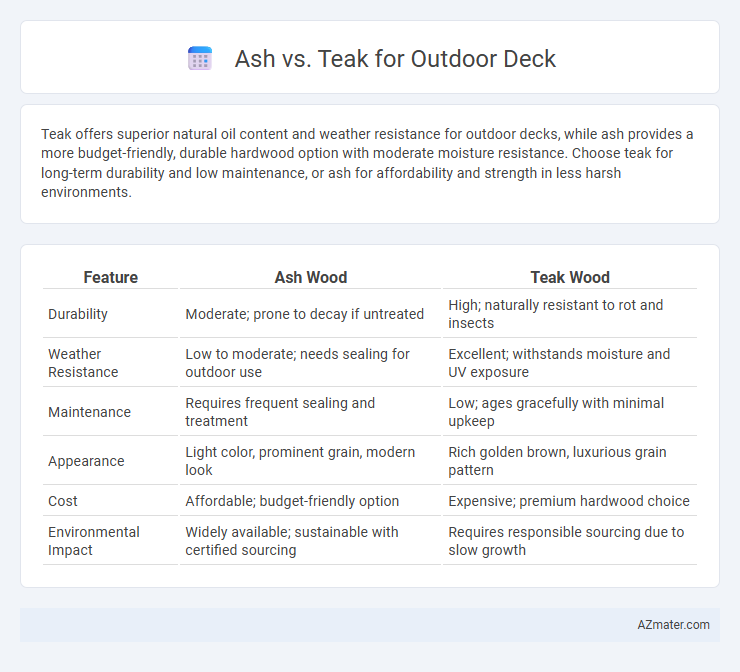Teak offers superior natural oil content and weather resistance for outdoor decks, while ash provides a more budget-friendly, durable hardwood option with moderate moisture resistance. Choose teak for long-term durability and low maintenance, or ash for affordability and strength in less harsh environments.
Table of Comparison
| Feature | Ash Wood | Teak Wood |
|---|---|---|
| Durability | Moderate; prone to decay if untreated | High; naturally resistant to rot and insects |
| Weather Resistance | Low to moderate; needs sealing for outdoor use | Excellent; withstands moisture and UV exposure |
| Maintenance | Requires frequent sealing and treatment | Low; ages gracefully with minimal upkeep |
| Appearance | Light color, prominent grain, modern look | Rich golden brown, luxurious grain pattern |
| Cost | Affordable; budget-friendly option | Expensive; premium hardwood choice |
| Environmental Impact | Widely available; sustainable with certified sourcing | Requires responsible sourcing due to slow growth |
Introduction to Ash and Teak for Outdoor Decks
Ash wood offers exceptional strength and durability, making it a popular choice for outdoor decks that require resilience against heavy foot traffic and weather exposure. Teak is renowned for its natural oils and dense grain, providing superior resistance to moisture, decay, and insect damage, which enhances longevity in outdoor environments. Both woods possess distinctive aesthetics, with ash showcasing a light, creamy color and teak featuring a rich, golden-brown hue that weathers to a sophisticated silver-gray over time.
Wood Characteristics: Ash vs Teak
Ash wood offers a light color with straight grain, known for its strength, flexibility, and shock resistance, making it suitable for outdoor decking where durability is essential. Teak wood boasts natural oils that provide superior water resistance and decay protection, along with a rich golden-brown color that ages gracefully under sun exposure. While ash is more affordable and easier to work with, teak delivers unmatched longevity and low maintenance, especially in harsh outdoor environments.
Durability and Weather Resistance
Ash offers strong durability with a hardness rating of 1320 on the Janka scale, making it resistant to wear and impact, while teak excels in weather resistance due to its natural oil content and silica, which protect it from moisture, rot, and insects. Teak's dense grain structure ensures exceptional longevity in outdoor environments, maintaining stability and resisting warping even under fluctuating humidity and temperature. Although ash is tough and cost-effective, teak is the superior choice for long-term outdoor decks where maximum durability and weather resistance are critical.
Maintenance Requirements
Ash wood requires regular sealing and oiling to maintain its durability and resist moisture, making it moderately demanding in terms of maintenance for outdoor decks. Teak naturally contains oils that resist water, insects, and decay, reducing the need for frequent treatment and making it a low-maintenance choice. Both woods benefit from periodic cleaning, but teak's dense grain and natural oils provide superior longevity with less upkeep compared to ash.
Aesthetic Appeal and Color Variations
Ash wood offers a light, creamy tone with prominent grain patterns that create a visually striking outdoor deck surface, perfect for contemporary and rustic designs. Teak wood, known for its rich golden-brown hues and natural oils, weathers to a distinguished silver-gray patina that enhances long-term aesthetic appeal. Both woods provide diverse color variations, but Ash leans toward brighter, more uniform shades while Teak delivers deep, warm tones that age gracefully under sunlight and weather exposure.
Cost Comparison
Ash decking typically costs between $3 to $7 per square foot, making it a moderately priced option compared to premium hardwoods. Teak, known for its durability and resistance to weather, ranges from $10 to $20 per square foot, reflecting its status as a luxury decking material. The higher cost of teak is offset by its superior longevity and low maintenance requirements, while ash offers a more budget-friendly solution with decent durability when properly treated.
Sustainability and Environmental Impact
Ash wood offers renewable sourcing and rapid regrowth, making it a sustainable choice for outdoor decking with a lower carbon footprint compared to slower-growing hardwoods. Teak, while highly durable and resistant to decay, often comes from tropical rainforests facing deforestation concerns, raising environmental impact issues unless certified by sustainable forestry programs. Choosing FSC-certified ash or teak ensures responsible harvest practices, balancing durability with reduced ecological disruption for eco-conscious deck construction.
Installation and Workability
Ash offers excellent workability due to its straight grain and uniform texture, making it easier to cut, shape, and fasten during outdoor deck installation. Teak's natural oils provide durability and resistance to moisture, but its dense, oily nature can make nailing and screwing more challenging, often requiring pre-drilling. Both woods require specific tools and techniques, but ash generally allows for quicker and more efficient installation with less effort.
Common Uses and Design Styles
Ash wood is commonly used for outdoor decking due to its strength, durability, and attractive light color, making it ideal for modern and contemporary design styles that emphasize clean, natural aesthetics. Teak is prized for its exceptional weather resistance, natural oils, and rich golden-brown hue, often featured in classic, tropical, and luxurious outdoor setups. Both woods offer unique textures and grain patterns, allowing versatility in design ranging from rustic to sleek, enhancing the visual appeal and longevity of outdoor decks.
Final Recommendation: Choosing Between Ash and Teak
Ash offers excellent strength and a lighter color palette, making it ideal for bright, natural outdoor decks, while teak provides superior durability and natural oil content, ensuring resistance to moisture and insects. Teak's dense grain and weather-resistant properties make it a premium choice for long-lasting outdoor applications, whereas ash requires proper sealing to maintain its appearance and longevity. For ultimate durability and low maintenance, teak is recommended, but ash serves as a cost-effective alternative for those seeking a lighter aesthetic with moderate upkeep.

Infographic: Ash vs Teak for Outdoor Deck
 azmater.com
azmater.com